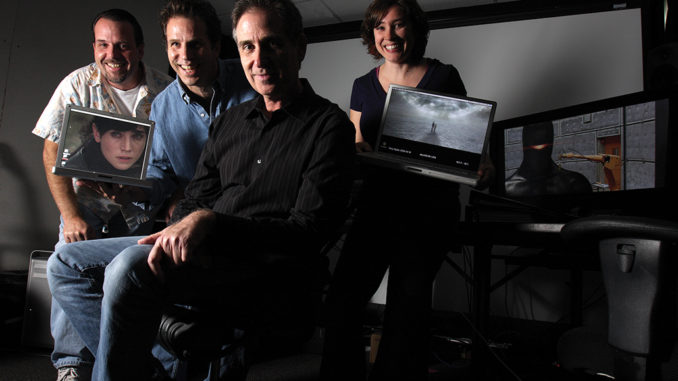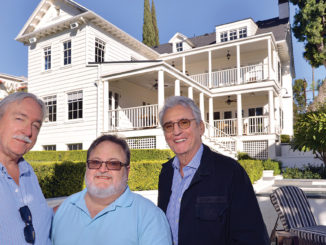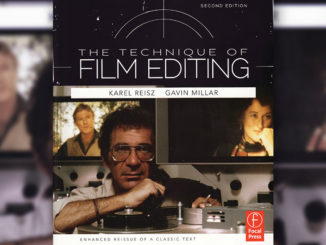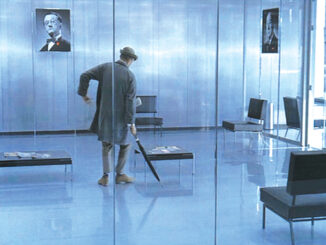
by Robin Rowe
Fifty-seven years after landing on Earth, in an ill-fated mission of peace, the alien Klaatu and his super-robot companion Gort have just made a return visit, touching down upon our planet again on December 12––when the remake of The Day the Earth Stood Still was released worldwide by 20th Century Fox.
The original 1951 black-and-white film, directed by former editor Robert Wise and edited by William Reynolds, is a parable of atomic-age paranoia in a science-fiction scenario. It has become an icon of American cinema. Rather than try to remake a classic, director Scott Derrickson decided to reinvent the story within a modern context––and using state-of-the-art visual effects––in the 2008 version. Keanu Reeves stars as Klaatu, and Jennifer Connelly is Helen, the earth woman who befriends him. This time around, the giant robot Gort is an all-CGI creation.
The new The Day the Earth Stood Still’s editor, Wayne Wahrman, A.C.E., was still cutting I Am Legend in LA when that film’s executive producer (and TDTESS producer) Erwin Stoff recommended him to Derrickson. He was ecstatic. “They called and asked if I’d be interested in doing the picture,” recalls Wahrman. “Of course, it was one of my favorite Cold War sci-fi movies!” says Wahrman. The movie was being prepped in Vancouver and the producers wanted Wahrman to fly up there for a meeting. “But that was impossible because I was still finishing I Am Legend,” he says. “I had an initial phone conversation with Scott. This is the only job I’ve ever gotten just on the phone.”
Was his editing informed by Wise’s film? “I was very familiar with it; I remembered it quite well,” Wahrman replies, explaining that, in fact, he did not even look at the original version of TDTESS while he was editing. “Our version of the film is quite a bit different. It’s updated.” As for the original’s editor, Wahrman offers, “I never met Bill Reynolds, but he definitely influenced me. I remember watching The Turning Point as a film student. He was an amazing editor.”
Wahrman believes that every movie has its own pace intrinsic in the material and the actors. “Actually, I think pace is an overused word,” he explains. “What you really want to do is involve an audience and intrigue and compel them––and draw them in. If you’re able to do that, then the pace of the film works.”
“Our main vendor was in New Zealand… We had another vendor in London, and several vendors here––more than we would have liked. I get 120 e-mails a day.” – Neil Greenberg
To that end, he did not impose any style or pre-conceived notions while cutting TDTESS. “I try to be as open-minded as possible to the material as it comes in,” says Wahrman. “Then, I let the film inform me how it should be put together, how it should be cut. I try to listen to the film and see where it leads me.
“Suspense is in how the scene unfolds, how you peel the artichoke,” he continues. “It’s revealing what you want to reveal when you want to reveal it.”
What about the visual effects? “A lot of the visual effects had been pre-visualized,” Wahrman explains. “When Scott went to shoot them, he was very faithful to getting those shots. The pre-viz was certainly a good roadmap, a point of departure. I would use the pre-viz sometimes as a placeholder for the real shots. And then, when they actually shot the scene, the scene would evolve.” Pre-visualization was utilized more on this picture than others on which Wahrman had worked. “That had to do with the director having a very clear vision,” he says. “And he imparted that in the pre-viz.”
Wahrman is also a big believer in the Avid Scripts system. “I put all the material into the scripts system and work with that. It’s a great time-saver, a great organizational tool.”
“A lot of what I did on the film was the stock footage… There’s a lot of stock footage in this film. We took a lot of footage from the visual effects department and added spheres [space ships] to it.” – Gordon Antell
“Scripter is a program that not a lot of editors use,” explains Catherine Haight, first assistant editor on The Day the Earth Stood Still. “Once you see it, you realize that it’s great. It can be a pain in the butt for assistants because it takes a long time to organize it. But it’s especially good when you’re sitting with the director. He can say, ‘I want to hear every line reading on that line,’ and you can show it to him super-easily.”
In Avid Scripts, the clips overlay the script similar to the way that a script supervisor marks pages as they’re shot, but with video available for immediate retrieval.
“With Scripts, you have this text file which is the script,” says Haight as she points to the screen of the Avid. “You put a marker for each line of dialogue. This is scene 8b, take 1. You have to highlight in the right section and put the clip in.
“This film marks the first time any of us has done an HD show,” she adds. “We’re running Media Composer 2.8, four Adrenalines and Unity. We have 5TB of storage. HD takes roughly 15GB for an hour of footage.”
Second assistant Gordon Antell has worked with Wahrman on several films over 16 years. “Gordon and I first worked together on Michael Mann’s Last of the Mohicans, so he knows how I like to work,” says Wahrman. “A lot of what I did on The Day the Earth Stood Still was the stock footage,” says Antell. “There’s a lot of stock footage in this film. We took a lot of footage from the visual effects department and added spheres [space ships] to it.”

Photo by WETA TM & Copyright 2008 Twentieth Century Fox Film Corporation
According to digital effects assistant editor Neil Greenberg, The Day the Earth Stood Still was a 24-hour operation. “Our main vendor was in New Zealand,” he says. “We had another vendor in London, and several vendors here––more than we would have liked. I get 120 e-mails a day. We set up a high-speed broadband pipe to New Zealand and London. With local vendors, you still have to write the drive and send it over. All the composites came to our office, so we did our own data management.”
“Neil is great because he’s very organized, very agile with the Avid,” adds Wahrman. “He could help me mock things up in a way that looked very professional in HD [using AfterEffects], which was helpful in visualizing our cut.”
“This movie was extensively pre-visualized,” explains Greenberg. “They’ve done cartoon versions of all the big action scenes. We set up the Avid project as 24fps, but found we really needed 23.98. Something like making a DVD really took a long time. We found that if we exported the QuickTimes, and then ran it through Compressor in Final Cut, we would get everything the right size and frame rate. Then we could burn it to DVD.
“On this show, we’ve incorporated a Scratch system for 2K playback,” he continues. “It’s actually for conforming, color correction and 2K playback.”
The new version of The Day the Earth Stood Still is geared to today’s movie-going audience, according to Wahrman. “There’s a whole generation of people who haven’t seen the original film; they don’t watch black-and-white movies.”





